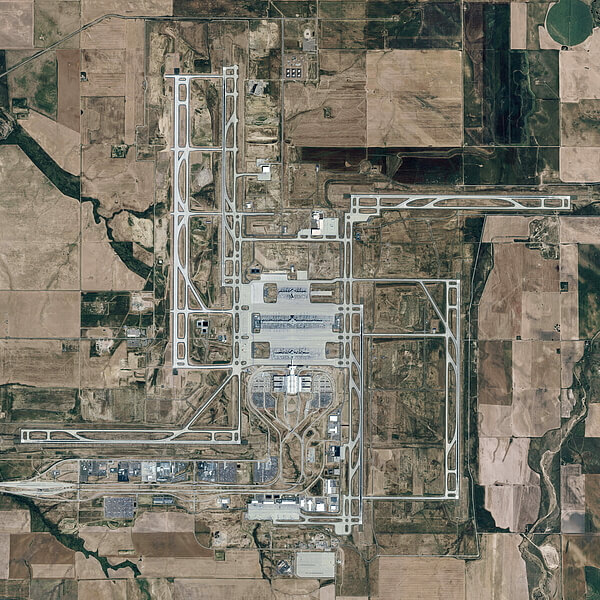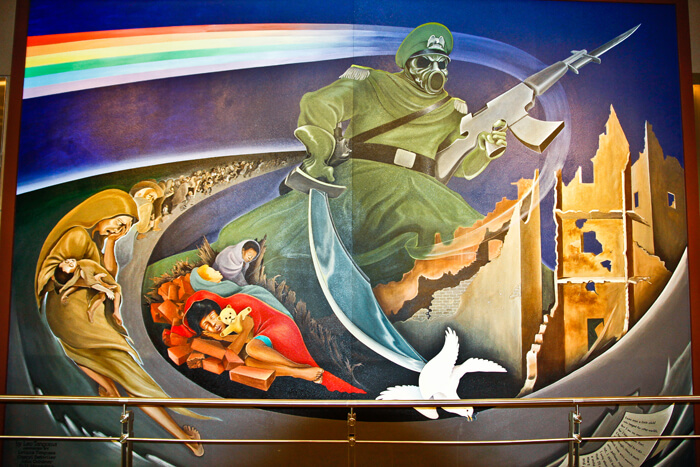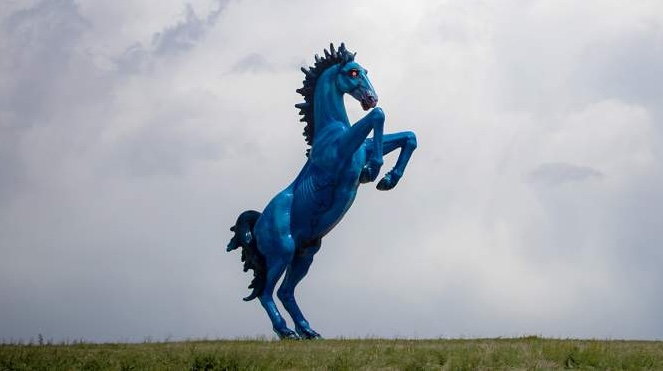Denver International Airport (DIA) has been one of the most talked-about airports in the world since it opened in 1995. Not because of its efficiency or architecture, but because of the conspiracy theories that surround its huge underground tunnels, disturbing artwork, and strange history of construction. DIA has become a hub for people who think that there are hidden messages throughout the building, from secret societies to prophecies of the end of the world.

The Base of Doubt
People started making up conspiracy theories about Denver International Airport even before it was finished being built. There were a lot of reasons why people were skeptical at first, but those doubts grew into complicated theories about what the airport was really for.
The Airport Question That Isn't Necessary
Denver already had a perfectly good airport at Stapleton when construction started in September 1989. Even though officials said that Stapleton had problems with crowded runways and scheduling, many residents wondered if a new airport was really needed. People who were skeptical of the airport construction were more likely to believe theories that it was a cover for something worse.
Unusual Construction
There were a lot of delays, cost overruns, and contractor changes during the airport's construction. The project was supposed to cost $1.5 billion, but it ended up costing $5.6 billion, which is almost four times what was planned. Conspiracy theorists thought that the contractors were switching jobs on purpose so that no one construction crew would know everything that was being built below the surface.
Fact or Fiction: The Underground Network
One of the most popular ideas about DIA is that it has a lot of tunnels underground. The airport admits that there are underground levels, but conspiracy theorists say that these tunnels are used for much worse things than what the airport says they are.
Official Infrastructure Below Ground
Airport officials say that the underground areas are used for real purposes:
- An automated system for handling luggage (now broken)
- Trains that run underground between terminals
- Places for maintenance and storage
- Workspaces for people who work at the airport
The airport says that about 1,000 people work in different underground levels every day and that the tunnels go about two miles to the airport's edge.
The Bunker Idea
People who believe in conspiracy theories say that there is a huge network of secret bunkers under these well-known buildings that are meant to hold the world's elites during an end-of-the-world event. Some claims say that there are:
- More than one underground level that goes much deeper than what is officially known
- Hidden tunnels that link DIA to NORAD, which is 90 miles away in Colorado Springs
- Underground cities that can hold thousands of people
- Places to store weapons and supplies
But experts in engineering say that building a 90-mile tunnel would be a huge challenge. The Gotthard Base Tunnel in Switzerland is the longest underground rail tunnel in the world. It is only 35.4 miles long and took more than ten years to build.

The Art of Conspiracy: How to Figure Out the Murals
There may not be a part of DIA that makes more conspiracy theories than its public art, especially the murals by artist Leo Tanguma.
"Children of the World Dream of Peace"
Many conspiracy theories have grown around this two-panel mural. The first panel shows:
- A soldier with a gas mask holding a sword and gun
- Children who are dead or dying
- Refugees who are running away
- Scenes of destruction and despair
The second panel shows:
- Kids from different cultures celebrating together
- The same soldier lying dead with doves on his body
- A child with a hammer breaking the soldier's sword
- Signs of peace and togetherness
"In Peace and Harmony with Nature"
The companion mural talks about the environment. The first part shows burning forests, animals that are no longer alive in display cases, and kids who are sad about how the environment is being destroyed. The second part shows people coming together to heal and enjoy nature.
What the Artist Wanted
Leo Tanguma has said many times that his murals were meant to spread messages of peace, healing the environment, and bringing the world together. He said about the conspiracy theories, "I thought and still think that these people are crazy. For instance, one religious leader said the mural was satanic. Some people said they saw demons."
Leticia Darlina Tanguma, Tanguma's daughter and collaborator, has made it clear that the murals show real kids from the Denver area, many of whom died in tragic ways and were remembered in the murals. The artist wanted the darker images to show the problems the world is facing right now, and the hopeful scenes to show that people can get through these problems.
Different Ways to Look at Conspiracies
Even though the artist tried to explain, conspiracy theorists see the murals as:
- Predictions of disasters that will happen around the world
- Proof of a plan for a New World Order
- Coded messages about plans to cut the population in half
- References to the end of the world in the Bible
Some theorists say that reading the murals backwards shows a different, more evil story about the future of humanity.

Blucifer: The Horse of the Devil
There is a 32-foot-tall, 9,000-pound fiberglass sculpture at the airport entrance called "Mustang," but people in the area call it "Blucifer." This blue horse with glowing red eyes has a dark past that makes people think of conspiracy theories.
The Artist's Curse
In 1992, sculptor Luis Jiménez was paid $300,000 to make the piece. But the project ran into a lot of problems with the law and delays. While he was working on the sculpture in his New Mexico studio in 2006, a part of it fell and pinned Jiménez against a steel beam, cutting an artery in his leg. He died on the way to the hospital from losing too much blood.
Jiménez's family and studio staff finished the sculpture after he died. It was finally shown to the public in February 2008, sixteen years after it was first ordered. The final price had gone up to $650,000.
Symbolism and Meaning
People think the red eyes are evil, but they are actually a tribute to Jiménez's father, who owned a neon sign shop where the artist worked as a child. The artist's own Appaloosa horse, Blackjack, and stories from the Southwest about blue mustangs gave the blue color its name.
Even with these explanations, the sculpture's big presence and the fact that its creator died in a tragic way have made it a target for people who think DIA is cursed or has dark powers.
More Mysterious Things
Links to Freemasonry
There is a dedication capstone at the airport's entrance with the Masonic symbol and the date March 19, 1994. The "New World Airport Commission," a group that has never been found or named, dedicated the stone. Some people who believe in conspiracy theories say this means that the Freemasons built the airport as part of a bigger plan for the world.
People who believe this theory say that there is Braille on the capstone that has a secret code in it. Some people think that the capstone could be a keypad that, when pressed, would open hidden rooms or time capsules.
Gothic and Gargoyle Elements
There are gargoyles coming out of suitcases in the baggage claim area at the airport. Airport officials say these are playful takes on Gothic architecture meant to "ward off evil spirits," but conspiracy theorists see them as more proof of occult symbolism.
Layout of the Runway
Some people who believe in conspiracy theories say that the airport's runways look like a swastika when seen from above. But aviation experts say that the fan-shaped runway layout is meant to make takeoffs and landings as smooth as possible in different wind conditions, which is something that all major airports do.
The "Au Ag" Puzzle
The chemical symbols for gold (Au) and silver (Ag) are on a time capsule that is buried at the airport. People who believe in conspiracy theories think this is about the "Australia Antigen," which they say is a deadly pathogen made to control the population. The Australia Antigen is not a bioweapon; it is used to diagnose and treat Hepatitis B.
Official Response and Plan for Marketing
Denver International Airport has not dismissed the conspiracy theories; instead, they have seen them as a unique way to market themselves. The airport has done a few things in the last few years, such as:
- Hosting an exhibit called "Conspiracy Theories Uncovered"
- Making ads that make fun of the theories
- Put up funny signs during construction projects
- Let workers add graffiti and "alien" art to underground areas
Officials at the airport have taken journalists on behind-the-scenes tours, showing them the boring reality of the underground facilities. They also said that no amount of evidence seems to convince true believers.
The Mindset Behind Conspiracy
The enduring nature of conspiracy theories surrounding Denver International Airport illustrates a fundamental human inclination to discern patterns and significance in atypical situations. There are a few things that make DIA especially open to conspiracy thinking:
When and Where
The airport opened in the 1990s, a time of big changes in society and technology that made people worried about globalization and secret societies. The end of the Cold War left a void of traditional enemies, which made secretive global groups seem like good targets for suspicion.
Size and Difficulty
DIA is hard for most people to understand because it is so big (52.4 square miles) and has a complicated infrastructure. This lack of understanding leaves room for the imagination to fill in the gaps.
Artistic Uncertainty
The artwork at the airport is meant to make people think about serious problems around the world, but the images can be read in different ways. Tanguma's murals have disturbing parts that, even in the peaceful setting they are in, make people feel uneasy and fuel conspiracy theories.
Problems with the Building
The real problems that happened during construction, like going over budget, being late, changing contractors, and technical failures, gave us a factual basis on which to build more complex theories.
Distinguishing Fact from Fiction
Denver International Airport does have some strange things that should be looked into, but most conspiracy theories don't have any real proof. The underground tunnels have real uses, the artwork sends real political and social messages, and the problems with construction are normal for big projects, not because of evil plans.
The theories, on the other hand, continue to exist because they deal with real fears about globalization, environmental destruction, and political power. The airport's willingness to accept the conspiracy theories instead of denying them has only made things worse, creating a cycle of mystery and speculation that keeps going.
Critical Analysis
While Denver International Airport certainly contains unusual elements that merit examination, it's important to distinguish between verifiable facts and unsubstantiated speculation. The underground infrastructure serves documented practical purposes, and the construction irregularities reflect typical challenges of large-scale projects rather than evidence of hidden agendas.
Conclusion
Denver International Airport is still a very interesting example of how strange building designs, artistic expression, and construction mistakes can all come together to make a whole mythology. Whether seen as harmless fun or dangerous lies, the conspiracy theories about DIA raise bigger questions about power, secrecy, and the search for meaning in a world that is getting more complicated all the time.
The truth about Denver International Airport may be much less interesting than the theories say, but the stories have become a part of Colorado's culture. In a world where secret societies and hidden agendas are interesting, DIA is a physical representation of our fears about what might be hiding in plain sight.
"The persistence of these conspiracy theories demonstrates how architectural anomalies, combined with artistic symbolism and construction irregularities, can create a perfect storm for mythological thinking. DIA serves as a modern case study in how facts and fiction can become intertwined in the public imagination."
